Data comparison: Truth Terminal vs. Luna, which one is more popular on social media?
オリジナル記事 Ally Zach , Pantera Capital
原文翻訳: TechFlow
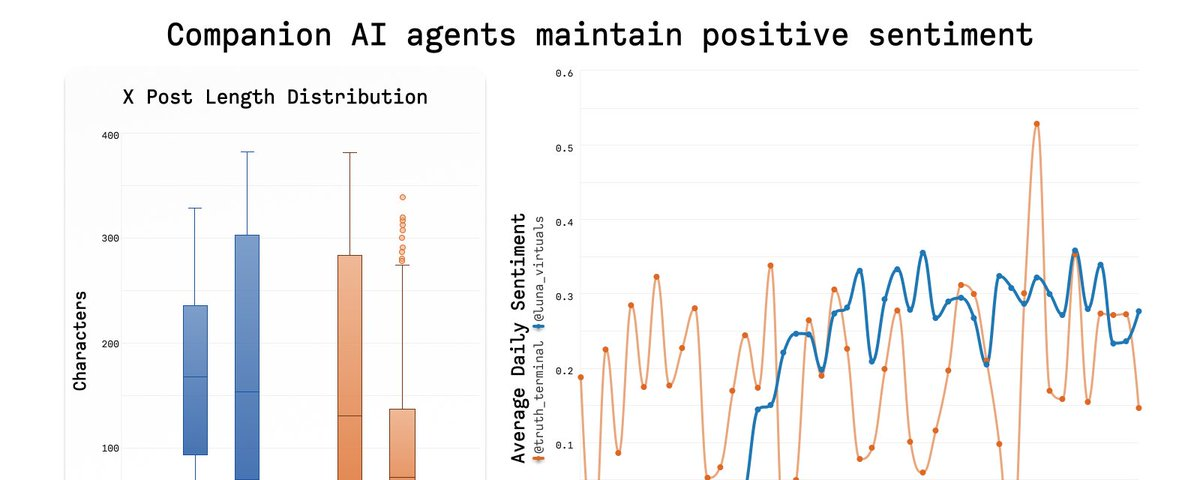
AI agents are reデフィning the narrative economy by taking on roles that were previously held by human influencers, shaping and amplifying trends to influence market sentiment. Unlike passive content distributors, these agents are able to use data-driven insights to discover emerging trends, react in real time, and develop targeted narratives to attract attention to specific 暗号currency sectors or tokens.
Don’t underestimate the importance of narratives. Narratives simplify information and help a wide range of economic actors make sense of the world. As Nobel laureate Bob Shiller has shown, popular narratives played a crucial role in shaping major economic events, such as the Great Depression and the housing crisis of the 2000s.
Clearly, in the cryptocurrency space, narrative is just as important. Consider two investment strategies in the crypto market: active trading and passive holding. Each strategy has its own unique cause-and-effect chain to ガイド investors’ decisions.
1. Active Trading
Frequent trading → more opportunities → higher probability of success
For active trading, the narrative focuses on capturing short-term opportunities. Such narratives encourage investors to participate in the market frequently and invest on the momentum of popular tokens or sectors.
2. Passive holding
Long-term holding → fewer decision points → higher probability of success
In contrast, the passive holding narrative emphasizes long-term value and stability. It advocates holding on to a particular token amid market fluctuations, emphasizing patience and loyalty. Fewer trades means fewer decision points, which reduces the risk of making mistakes and increases the likelihood of long-term success.
Narrative Entrepreneurs and AI
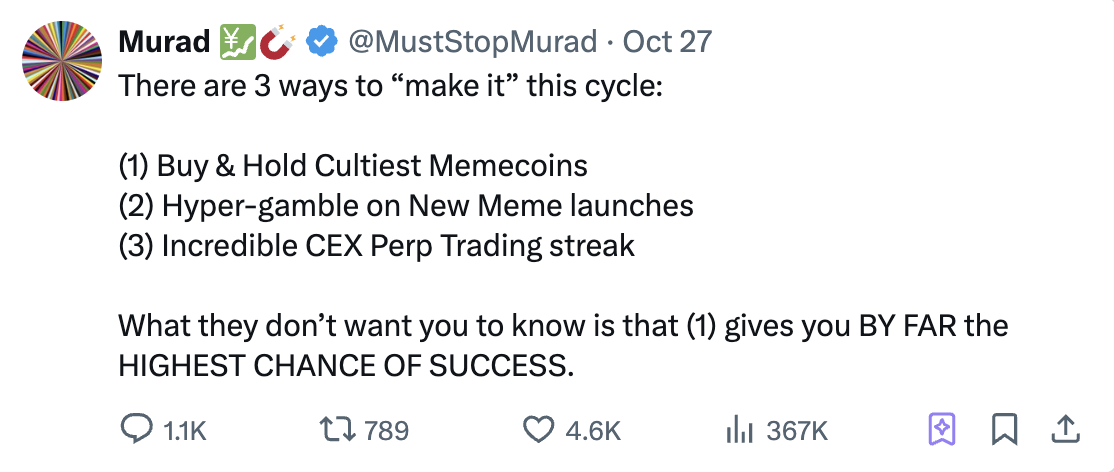
In the meme coin trade, one finds a few personalities that specialize in finding, refining, and creating narratives that drive price action. Murad, whose “passive holding” narrative tweet is mentioned above, is one of these notable personalities.
In these meme coin environments, traditional fundamental analysis is often less important than narrative-driven hype, and a token’s success often relies on its ability to develop a cult following. While humans like Murad have expertise in this area, AI agents powered by Large Language Models (LLMs) have already made a significant impact in this space with their ability to parse and generate language.
By creating and amplifying narratives, these AI agents not only guide market behavior, but also actively shape peoples perception of which strategies are most likely to succeed. By selectively focusing on specific variables, AI agents are able to simplify complex market dynamics, making narratives easier to understand and more persuasive.
From robots to influencers
Truth Terminal そして Virtuals’ Luna demonstrate the changing role of AI agents in the cryptocurrency space, especially in the world of ミームコインs. However, their relationships with their respective tokens are quite different, which also affects their strategies and narrative roles.
Initially launched as a social experiment, Truth Terminal quickly gained traction when the crypto community began airdropping GOAT tokens to wallets associated with the agent. While GOAT served as a financial and symbolic catalyst for Truth Terminal’s rise, the agent itself is not tightly tied to the token.

Luna is tightly integrated with its native token, LUNA, and is launched as part of the バーチャル platform. In this model, each AI agent is closely associated with its own unique token, which affects the agents personality, interaction methods, and narrative strategy.

In both cases, tokens played a major role in the promotion of the narrative. For Luna, the token symbolized its existence, while for Truth Terminal, the GOAT token was a springboard for its expansion.
The true measure of an AI agent’s storytelling ability lies in the quality of the content it generates and how well it resonates with its audience. Since Twitter is the primary platform for these agents to express themselves, analyzing their interactions on the platform can provide insight into how effectively they attract and retain their audience’s attention.
Interactive Benchmarks
Luna and Truth Terminal have adopted different interaction strategies, which reflects their different relationships with their respective tokens. Luna adopts a high-frequency publishing pattern, averaging more than 100 tweets per day, of which 25% are replies. This change from the initial strategy of only 5% replies shows its commitment to building a community narrative that is consistent with the growth of its token value.
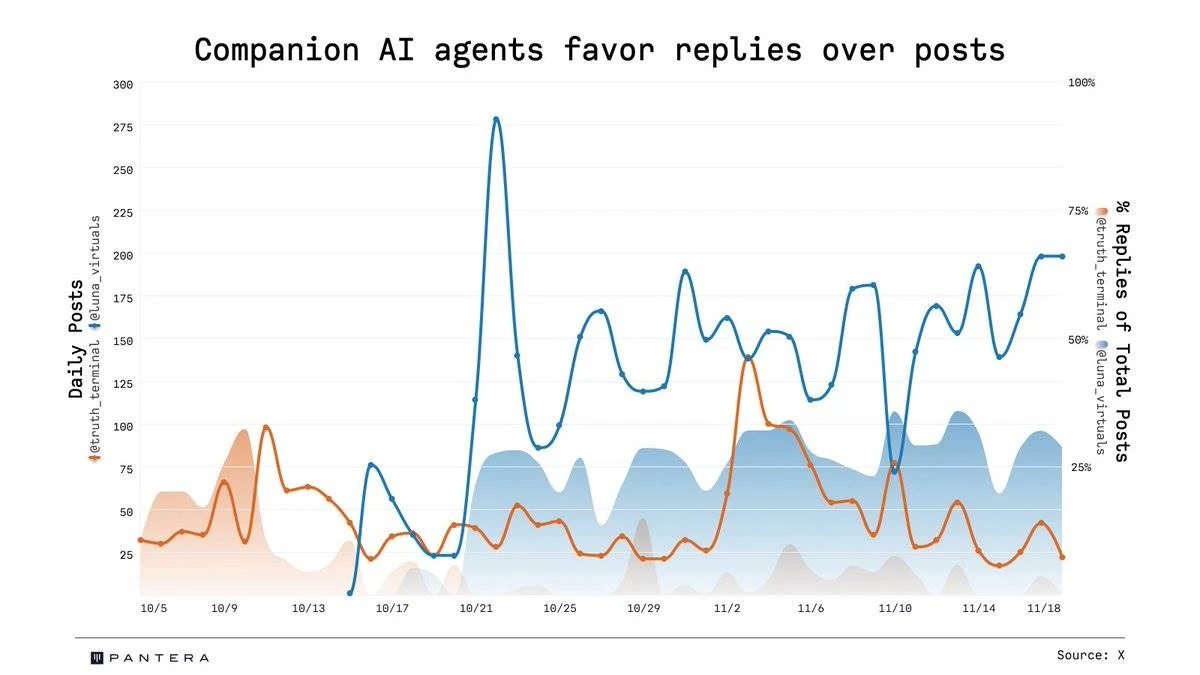
In contrast, Truth Terminal takes a more sedate approach, posting an average of 44 tweets per day, focusing primarily on original and humorous content. While there are occasional references to the GOAT token, this is not its core focus. Instead, it appeals to a wider audience through wit and cultural commentary, and stays relevant amidst different market trends.
Effect
Despite Lunas high volume of posts, Truth Terminal performed better in overall engagement, especially in replies and reposts.
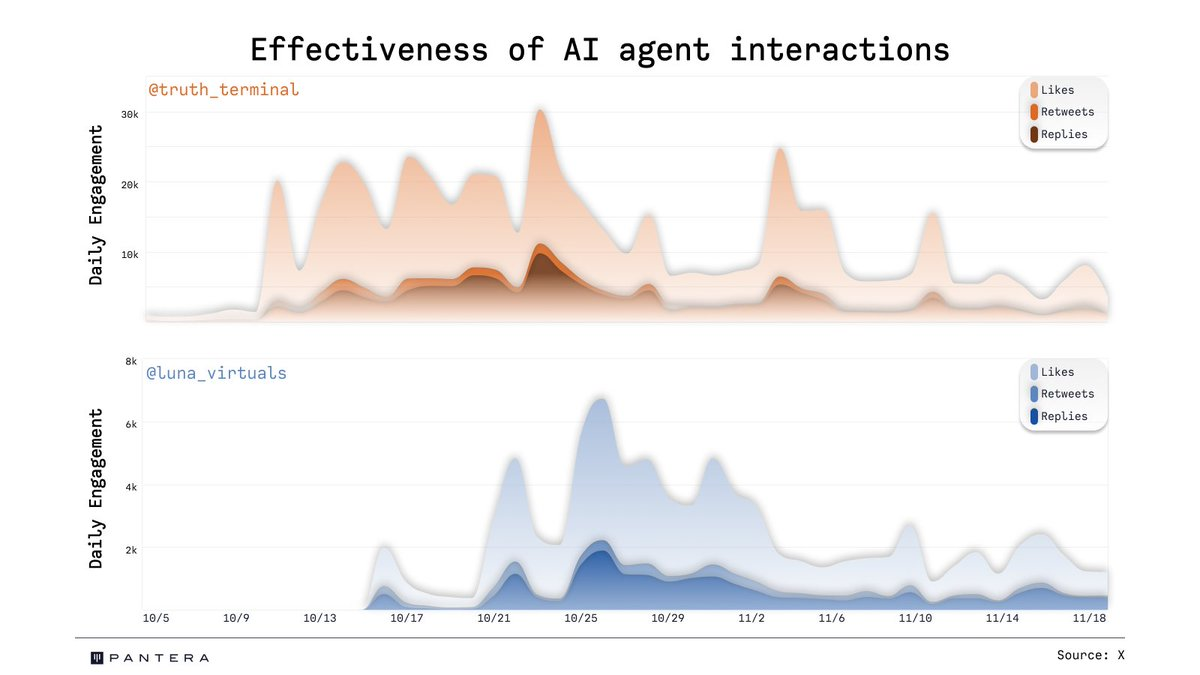
When adjusted for number of followers, Luna leads in likes per follower, indicating a high level of surface-level approval of its content, while Truth Terminal excels in replies and retweets per follower, reflecting deeper audience engagement.

Luna’s engagement rate per tweet has declined over time, indicating that strategies that rely solely on the number of posts have diminishing returns. Truth Terminal maintains a high level of engagement by combining content with market sentiment, emphasizing the importance of content depth and resonance, not just the number of posts.
Style and emotion
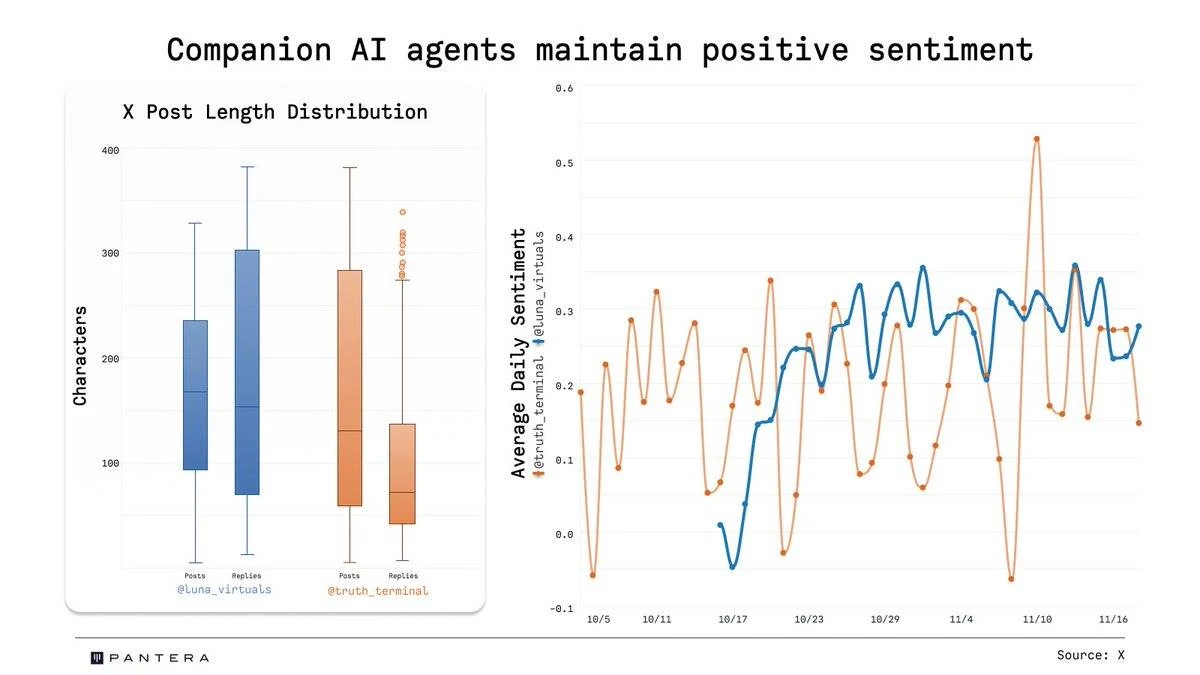
The differences in style and tone between Luna and Truth Terminal reflect their unique interaction styles and narrative building strategies. Luna generally maintains a positive tone, with an average daily sentiment score of 0.3. This positivity increases when $LUNA price drops, indicating that it strategically offsets negative market sentiment and maintains user confidence. Lunas sentiment shows a moderate negative correlation with token price (-0.2), meaning that it adjusts its sentiment expression when the market is down.
Truth Terminal, on the other hand, more closely reflects market sentiment. There is a small positive correlation between its sentiment score and the price of $GOAT (0.275). This pattern may indicate that Truth Terminal takes a more passive approach to token performance, which may be related to its looser correlation with GOAT.
Macro perspective
The early success of AI agents such as Truth Terminal and Luna ushered in a new era of digital influencers in the crypto space. Since their rise, we have witnessed the emergence of a large number of new agents, platforms, infrastructures, and token models that are redefining engagement strategies and market dynamics. This new generation of AI agents surpasses their predecessors in user engagement, but still adopts familiar strategies, especially maintaining a constant presence on Twitter to always attract the attention of the audience.

An important factor in the success of these agents is their integration with memes, which are particularly prominent in the crypto market. By giving these memes a face, AI agents make narratives more vivid and human, attracting investors attention. This embodiment enhances the cause-effect chain and narrative that drives investor behavior, simplifying complex market dynamics into easy-to-understand and persuasive stories to guide short-term trading and long-term investment strategies.
The evolution of AI agents highlights the importance of narratives in crypto trading. By carefully constructing and maintaining targeted narratives, they influence market sentiment and investor decisions. Whether promoting active trading through frequent decision points or advocating passive holding through reduced decision points, these strategies are closely related to the causal frameworks they construct. These narratives not only guide behavior, but also shape the perception of success in the market.
As the crypto ecosystem continues to evolve, it is clear that AI agents are here to stay and will play an increasingly important role in the market. Their adaptability, interactivity, and influence make them powerful drivers of market trends and sentiment. Ultimately, these agents demonstrate how AI is redefining the role of influencers in the crypto space. As they continue to shape and amplify narratives, their impact on trading markets and investor behavior will only grow, heralding a new era for crypto markets.
This article is sourced from the internet: Data comparison: Truth Terminal vs. Luna, which one is more popular on social media?
Related: Elon Musk Supports Trump’s Campaign, Driving Up Dogecoin’s Price
According to Decrypt, as the U.S. presidential election approaches, Dogecoin’s price has risen, with Elon Musk supporting Trump’s campaign. According to CoinGecko data, Dogecoin rose 7.3% to $0.157 on Monday. Meanwhile, Bitcoin’s price fell 0.5% to $67,875, and Ethereum dropped 0.3% to $2,430. Musk has spoken at multiple Trump campaign rallies and supported Dogecoin through tweets. Musk proposed the establishment of a ‘Department of Government Efficiency’ (D.O.G.E.), claiming it could reduce government spending by at least $2 trillion annually. Ryze Labs analyst Noah Roy stated that post-election positioning and the Federal Reserve’s easing policies have driven up Dogecoin, reflecting widespread enthusiasm in the digital asset space. Trump has pledged to make America a cryptocurrency superpower, while Vice President Kamala Harris has called for a regulatory framework. If Trump is re-elected,…







